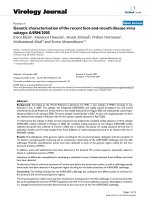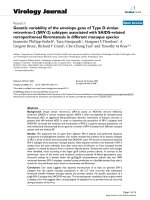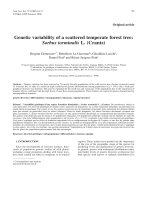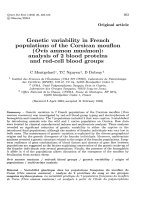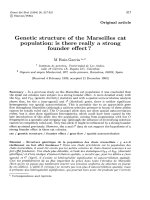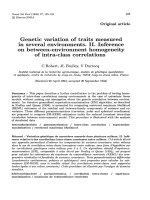Báo cáo sinh học: "Genetic variability of muscle biological characteristics of young Limousin bulls" ppt
Bạn đang xem bản rút gọn của tài liệu. Xem và tải ngay bản đầy đủ của tài liệu tại đây (661.91 KB, 12 trang )
Original
article
Genetic
variability
of
muscle
biological
characteristics
of
young
Limousin
bulls
G Renand
C
Jurie
J
Robelin
B
Picard
2
Y
Geay
2
F
Ménissier
1
Institut
national
de
la
recherche
agronomique,
station
de
génétique
quantitative
et
appliquée,
78352
Jouy-en-Josas
cedex,
France;
2
Institut
national
de
la
recherche
agronomique,
laboratoire
croissance
et
métabolisme
des
herbivores,
UR
croissance
musculaire,
63122
Saint- Genès- Champanelle,
France
(Received
6
May
1994;
accepted
13
January
1995)
Summary -
Genetic
parameters
of
4
muscle
biological
characteristics
(protein
to
DNA
ratio
(Pro/DNA),
lactate
dehydrogenase
(LDH)
activity,
isocitrate
dehydrogenase
(ICDH)
activity
and
the
proportion
of
type
I
myosin
heavy
chains
(MHC
I)),
in
the
Semitendi-
nosus
and
the
Longissimus
thoracis,
were
estimated
simultaneously
with
average
daily
gain
(ADG),
480-d
final
weight
(FW),
carcass
lean
and
fat
contents
(CL%
and
CF%
re-
spectively)
in
a
sample
of
young
Limousin
bulls
tested
in
station.
The
data
came
from
144
animals,
the
progeny
of
15
sires.
Sire
and
residual
variances
and
covariances
were
estimated
using
an
expectation
maximization
restricted
maximum
likelihood
(EM-REML)
procedure
applied
to
a
multitrait
mixed
model.
Heritability
coefficients
of
production
traits,
ADG,
FW,
CL%
and
CF%,
were
0.19, 0.49, 0.39
and
0.43,
respectively,
while
heritability
coeffi-
cients
of
muscle
characteristics,
Pro/DNA,
LDH,
ICDH
and
MHC
I,
were
0.11, 0.26,
1.03
and
0.35
respectively,
in
the
Semitendinosus
muscle
and
0.29, 0.31,
0.28
and
0.41,
respec-
tively,
in
the
Longissimus
thoracis
muscle.
In
both
muscles,
the
oxidative
activity
of
the
ICDH
appeared
to
be
genetically
associated
with
the
proportion
of
type
I
myosin
heavy
chains
and
opposed
to
the
glycolytic
activity
of
the
LDH.
The
LDH
activity
was
clearly
associated
with
higher
muscle-to-fat
ratio,
while
the
opposite
relationship
was
observed
between
that
ratio
and
the
ICDH
activity
or
the
MHC
I
proportion.
beef
cattle
/
genetic
parameter
/
growth
/
carcass
/
muscle
characteristics
Résumé -
Variabilité
génétique
de
caractéristiques
biologiques
du
muscle
chez
des
taurillons
Limousins.
Les
paramètres
génétiques
de
4
caractéristiques
biologiques -
le
rapport
protéines
/ADN
(ProIDNA),
les
activités
de
la
lactate
déshydrogénase
(LDH)
et
de
l’isocitrate
déshydrogénase
(ICDH)
et
la
proportion
en
chaînes
lourdes
de
myosine
lente
(MHC
I) -
des
muscles
Semitendinosus
et
Longissimus
thoracis,
et
ceux
du
gain
moyen
quotidien
(ADG),
du
poids
vif finaL
à
480 j
(FW)
et
des
teneurs
de
la
carcasse
en
muscles
et
en
dépôts
adipeux
(CL%
and
CF%
respectivement),
ont
été
estimés
simultanément
à
partir
d’un
échantillon
de
taurillons
Limousins
contrôlés
en
station.
Le
fichier
comprenait
144
veaux
issus
de
15
pères
testés
sur
descendance.
Les
variances
et
covariances
paternelles
et
résiduelles
ont
été
estimées
par la
méthode
du
maximum
de
vraisemblance
restreinte,
avec
l’algorithme
d’espérance-maximisation,
appliquée
à
un
modèle
mixte
multicaractère
(EM-REML).
Les
coefficients
d’héritabilité
des
variables
de
production,
ADG,
FW,
CL%
et
CF%,
s’élevaient
respectivement
à
0,19,
0,49,
0,39
et
0,43,
tandis
que
les
coefficients
d’héritabilité
des
caractéristiques
musculaires,
Pro/DNA,
LDH,
ICDH
et
MHC
I,
valaient
respectivement
0,11, 0,26,
1,03
et
0,35
dans
le
muscle
Semitendinosus
et
0,29, 0,31,
0,28
et
0,4i
dans
le
muscle
Longissimus
thoracis.
Dans
les
2 muscles,
l’activité
o!édative
de
l’ICDH
était
génétiquement
associée
à la
proportion
de
myosine
lente
et
opposée
à
l’activité
glycolytique
du
LDH.
Cette
activité
du
LDH
était
positivement
corrélée
avec
le
rapport
muscles
/
dépôts
adipeux,
alors
qu’une
relation
inverse
était
observée
avec
l’activité
de
l’ICDH
et la
proportion
de
MHC
I.
bovin
à
viande
/ paramètre
génétique
/ croissance
/ carcasse
/ caractéristique
musculaire
INTRODUCTION
The
objective
for
improving
beef
traits
in
most
production
systems
is
to
simulta-
neously
increase
the
economic
margin
of
producers
and
meet
the
consumers’
re-
quirements
relative
to
meat
quality.
Among
the
numerous
components
involved
in
the
biological
efficiency
of
meat
production,
muscle
growth
capacity
appears
to
be
determinant
whatever
the
species
(Dickerson,
1982;
Sellier
et
al,
1992).
In
cattle,
a
large
genetic
variability
of
beef
traits
has
been
shown
to
exist
among
breeds
as
well
as
within
breeds
(Koch
et
al,
1982;
Cundiff
et
al,
1986;
Renand
et
al,
1992).
Ge-
netic
improvement
can
therefore
be
obtained
by
the
appropriate
choice
of
breeding
animals,
since
heritability
coefficients
average
0.35-0.40
for
live
growth
traits
and
0.45-0.50
for
carcass
composition
traits.
In
most
selection
programs
the
primary
selection
criterion
is
live
growth
rate.
Up
to
now,
meat
quality
has
not
been
included
in
beef
selection
programs
since
there
is
no
economic
incentive
for
improving
it
and
objective
methods
of
measurement
on
a
large
scale
are
still
lacking.
However
different
studies
have
shown
that
a
moderate
but
significant
proportion
of
the
large
individual
variability
observed
for
meat
quality
traits
is
under
genetic
control
among
or
within
breeds
(Koch
et
al,
1982;
Cundiff
et
al,
1986;
Renand,
1993).
These
results
suggest
that
genetic
improvement
could
be
made
as
long
as
potential
sires
could
be
tested
and
selected,
although
the
estimated
heritability
coefficients
are
lower
than
for
production
traits,
0.20-0.30
on
average
(Renand,
1993).
Although
not
directly
selected,
meat
quality
components
may
change
as
a
consequence
of
selection
for
production
traits,
as
long
as
they
are
genetically
linked.
Therefore
definition
of
selection
programs
to
improve
meat
production
efficiency
and
meat
quality
requires
the
genetic
variability
of
the
different
components
to
be
estimated
simultaneously.
The
quality
of
the
meat
to
be
taken
into
account
are
the
sensory
measurements
related
to
the
color,
tenderness,
flavor
and
juiciness
of
the
higher
priced
joints
that
are
roasted
or
broiled.
Most
of
these
quality
traits,
especially
tenderness,
originate
from
post-mortem
aging
of
muscles
and
are
therefore
related
to
the
biological
characteristics
of
the
muscles
before
slaughter,
and
more
precisely
to
the
contractile
and
metabolic
types
of
muscles
(Valin,
1988;
Ouali,
1991).
Three
types
of
fibers
can
be
distinguished
in
adult
cattle
according
to
their
contractile
activity
(slow
or
fast)
and
their
energy
metabolism
(aerobic
or
anaerobic):
type
I
or
slow
oxidative
(SO),
type
IIa
or
fast
oxidative-glycolytic
(FOG),
and
type
lib
or
fast
glycolytic
(FG).
However
very
little
is
known
about
the
genetic
variability
of
these
characteristics
and
their
relationship
with
production
traits.
The
present
contribution
aims
at
giving
the
first
within-breed
genetic
parameters
of
muscle
biological
characteristics
of
French
Limousin
cattle.
MATERIALS
AND
METHODS
Animals
For
estimating
the
genetic
variability
in
the
French
Limousin
breed,
the
progeny
testing
results
of
sires
used
by
artifical
insemination
(AI)
were
used.
The
selection
program
of
Limousin
AI
sires
includes
a
centralized
progeny
testing.
Each
year,
purebred
Limousin
cows
are
randomly
inseminated
with
the
semen
of
potential
young
sires
and
a
sample
of
about
30
male
progeny
per
sire
is
gathered
in
a
central
testing
station
after
weaning
at
7-8
months
of
age.
The
young
bull
progeny
are
distributed
in
contemporary
groups
according
to
their
birth
date
and
fed
a
similar
diet
with
corn
silage
adequately
complemented
and
distributed
ad
libitum,
up
to
a
constant
final
slaughter
age
of
16
months.
During
fattening,
cattle
are
weighed
monthly.
They
are
tested
on
live
growth
traits
and
on
carcass
weight
and
conformation.
In
1991,
a
group
of
15
potential
AI
sires
was
tested
on
432
young
bull
progeny
slaughtered
between
9
April
and
23
July.
A
sub-sample
of
these
progeny
was
selected
among
the
young
bulls
slaughtered
between
28
May
and
2
July
to
study
the
carcass
composition
and
muscle
characteristics.
It
included
144
animals
after
3
of
them
had
been
eliminated
due
to
sanitary
problems.
The
constitution
of
these
samples
is
reported
in
table
I.
In
the
experimental
sub-sample
each
sire
was
represented
by
8-10
progeny
(9.6
on
average).
The
testing
inseminations
were
performed
in
different
districts
of
south-western
France
with
different
management
and
climate
conditions,
and
so
3
different
groups
of
origin
(region
x
management)
were
defined,
with
37-68
animals
each.
The
144
experimental
animals
were
born
in
a
2
month
period
and
were
distributed
in
6
different
contemporary
groups,
with
20-28
animals
each.
Traits
analysed
Average
daily
gain
(ADG)
during
the
8
months
fattening
period
and
480-d
live
weight
(FW)
before
leaving
for
slaughtering
were
recorded.
Carcass
composition
was
estimated
according
to
Robelin
and
Geay
(1975)
from
the
dissection
of
the
llth
rib
cut.
Carcass
lean
or
fat
contents
were
computed
as
the
ratio
of
the
estimated
lean
or
fat
weights
to
the
cold
carcass
weight.
According
to
most
studies
on
meat
quality,
muscle
characteristics
were
measured
on
a
sample
of
the
Semitendinosus
(ST)
and
Longissimus
thoracis
(LT)
muscles
since
they
correspond
to
higher
priced
joints
where
sensory
qualities
are
important.
Measurement
methods
have
been
fully
described
by
Jurie
et
al,
1994.
The
protein
and
DNA
contents
were
measured
(Lowry
et
al,
1951;
Labarca
and
Paigen,
1980)
and
combined
into
a
ratio
of
protein
to
DNA
(Pro/DNA)
as
an
indirect
measure
of
protein
synthesis
and
hypertrophy.
The
oxidative
metabolism
has
been
quantified
by
the
measurement
of
the
isocitrate
dehydrogenase
(ICDH)
activity
(Briand
et
al,
1981).
The
anaerobic
glycolytic
metabolism
has
been
quantified
by
the
measurement
of
the
lactate
dehydrogenase
(LDH)
activity
(Ansay,
1974).
The
contractile
type
has
been
quantified
by
the
proportion
of
type
I
(slow
twitch)
myosin
heavy
chains
(MHC
I)
measured
by
Elisa
immunological
assay
(Picard
et
al,
1994).
Analysis
methods
In
addition
to
the
sire
effect
(s!),
the
factor
of
interest
to
estimate
the
genetic
variability,
the
statistical
model
included
both
the
origin
(O
i)
and
the
contemporary
group
(C
j)
effects
for
correction.
For
each
trait,
the
model
was
as
follows:
where
y2!!1
was
the
record
of
a
trait
for
a
young
bull
from
the
ith
group
of
origin,
in
the
jth
contemporary
group
and
progeny
of
the
kth
sire;
Oi
was
the
fixed
effect
of
the
ith
group
of
origin;
Cj
was
the
fixed
effect
of
the
jth
contemporary
group; s
k
was
the
random
effect
of
the
kth
sire,
sires
being
unrelated;
ei!k1
was
the
random
residual.
All
traits
were
analysed
simultaneously
in
a
multiple-trait
model.
The
sire
and
residual
variances
and
covariances
were
estimated
by
the
restricted
maximum
likelihood
(REML)
method
(Patterson
and
Thompson,
1971),
using
the
expectation
maximization
(EM)
algorithm
(Dempster
et
al,
1977).
Taking
advantage
of
the
fact
that
all
traits
had
identical
design
matrices,
a
canonical
transformation
was
used.
The
estimated
(co)variances
were
classically
combined
to
compute
heritability,
genetic
and
phenotypic
correlation
coefficients.
No
exact
standard
errors
of
the
genetic
parameters
could
be
computed
due
to
the
method
used
to
estimate
the
(co)variances.
Roughly,
only
heritability
coefficients
higher
than
0.4
could
be
considered
significant.
A
principal
component
analysis
has
been
performed
on
the
genetic
correlation
matrix
for
each
muscle
including
both
production
traits
and
biological
characteristics.
RESULTS
AND
DISCUSSION
Fixed
effects,
means
and
phenotypic
standard
deviations
Among
the
fixed
effects
included
in
the
model,
the
contemporary
group
effect
was
significant
on
almost
all
the
traits,
certainly
resulting
from
numerous
unidentified
environmental
effects.
The
origin
group
effects
appeared
to
be
significant
only
for
live
growth
traits.
When
tested
in
the
station,
the
calves
that
were
reared
indoors
in
their
herd
of
origin
had
a
lower
growth
rate
(—8%)
as
compared
to
calves
reared
at
pasture.
They
also
had
a
lower
carcass
fat
content
(—0.5
percent
units)
and
a
lower
protein
to
DNA
ratio
(—5%)
in
both
muscles.
However
these
effects
were
not
significant.
Means,
phenotypic
standard
deviations
and
heritability
coefficients
are
reported
in
table
II.
As
previously
described
in
detail
by
Jurie
et
al
(1994)
the
energy
metabolism
was
more
glycolytic
and
less
oxidative,
and
the
contractile
type
was
faster
in
the
ST
as
compared
to
the
LT
muscle.
The
phenotypic
variability
of
the
biological
characteristics
measured
in
both
muscles
was
relatively
large,
with
coefHcients
of
variation
around
20%.
This
variability
was
larger
than
those
observed
for
production
traits,
which
showed
coefficients
of
variation
lower
than
13%.
Heritability
coefficients
of
live
growth
traits
were
within
the
range
of
most
of
the
estimates
published
in
the
literature:
in
the
lower
range
for
ADG
(h
2
=
0.19)
and
in
the
upper
range
for
final
age
weight
(h
2
= 0.49).
The
heritability
of
carcass
composition
traits,
h2
=
0.38
for
lean
and
h2
= 0.43
for fat
content,
were
close
to
the
average
values
computed
from
estimates
in
the
literature,
h2
=
0.44
and
h2
=
0.49,
respectively
(Renand
et
al,
1992).
These
estimates
showed
that
the
genetic
variability
in
this
sample
of
Limousin
young
bulls
was
representative
of
the
genetic
variability
generally
observed
for
similar
traits
measured
on
cattle
tested
in
stations.
Most
of
the
biological
muscle
characteristics
(6
out
of
8)
presented
heritability
coefficients
in
the
range
h2
=
0.26
to
0.41.
However,
2
characteristics
measured
on
the
ST
muscle
had
quite
different
values,
as
low
as
h2
=
0.11
for
the
ratio
protein/DNA
and,
surprisingly,
as
high
as
1.03
for
ICDH.
There
may
be
many
reasons
for
these
extreme
values
and
the
relatively
limited
size
of
the
sample
was
certainly
the
major
one.
Except
for
these
2
characteristics,
the
apparent
genetic
variability
of
the
biological
muscle
characteristics
was
equivalent
to
the
genetic
variability
of
live
growth
traits
and
therefore
slightly
inferior
to
the
genetic
variability
of
carcass
composition
traits;
about
30%
of
the
observed
variability
of
these
characteristics
appeared
to
be
under
control
of
additive
genetic
effects.
In
the
literature
no
similar
characteristics
could
be
found
for
comparison.
Andersen
et
al
(1977)
published
estimates
of
heritability
coefficients
of
fiber
type
percentages
in
the
Longissimus
dorsi
of
Danish
Red,
or
Danish
Black
and
White,
or
Danish
Red
and
White
cattle.
The
fibers
were
typed
on
histological
slices
stained
with
Sudan
black
B,
which
is
particularly
absorbed
by
the
lipids
predominantly
associated
with
red
fibers
and
to
a
less
extent
with
intermediary
fibers.
The
heritability
coefficients
they
obtained
averaged
h2
=
0.29
(h
2
=
0.22
to
=
0.38)
for
fiber
type
percentages
and
diameters.
These
estimates
were
slightly
lower
than
the
coefficients
estimated
for
live
growth
or
carcass
composition
traits
they
found
in
their
study
(respectively
around
h2
=
0.42
and
=
0.48).
In
sheep,
Vigneron
et
al
(1986)
found
that
the
percentage
of
type
b
(type
I)
fibers
in
the
Scutuloauricularis
superficialis
accessorius
muscle,
a
small
muscle
of
the
ear,
determined
histoenzymologically,
had
a
relatively
large
genetic
component, h
2
=
0.27, 0.46,
and
0.97
in
3
different
breeds
(M6rinos
d’Arles,
Berrichon
x
Romanov,
and
ite
de
France,
respectively).
In
swine,
no
estimate
of
within-breed
genetic
variability
could
be
found
for
fiber
types,
while
estimates
of
fiber
diameter
averaged
h2
=
0.32
in
2
Danish
studies
reported
by
Staun
(1972).
Phenotypic
correlations
The
phenotypic
correlation
coefficients
(rp)
are
reported
in
table
III.
They
were
not
markedly
different
from
the
raw
correlations
previously
computed
from
variables
uncorrected
for
the
identified
fixed
effects
(Jurie
et
al,
1994).
In
general
these
coefficients
were
low.
The
only
notable
relationships
were
the
positive
relationship
between
the
oxidative
activity
(ICDH)
and
the
proportion
of
type
I
myosin
(rp
=
+0.31
and
rp
=
+0.41
respectively
in
the
ST
and
the
LT
muscle)
both
in
opposition
to
the
glycolytic
activity
(rp
=
-0.20
and
rp
=
-0.30
respectively
for
the
oxidative
activity
and
rP
=
-0.44
and
rP
=
-0.48
respectively
for
the
proportion
of
type
I
myosin).
The
phenotypic
correlations
between
similar
characteristics
measured
in
both
muscles
were
very
low.
Similarly
no
clear
phenotypic
relationship
appeared
between
muscle
biological
characteristics
and
production
traits.
Genetic
correlations
The
genetic
correlation
coefficients
are
reported
in
table
IV.
In
general
they
were
much
higher
than
the
phenotypic
coefficients.
There
was
a
clear
genetic
antagonism
between
the
glycolytic
activity
(LDH)
and
the
proportion
of
type
I
myosin
(rg
=
-0.72
and
rg
=
-0.87
respectively
in
the
ST
and
the
LT
muscle).
The
oxidative
activity
(ICDH)
was
clearly
associated
with
the
proportion
of
type
I
myosin
(rg
=
+0.64
and
rg
=
+0.28
respectively
in
both
muscles)
and
opposed,
to
a
lesser
extent,
to
the
glycolytic
activity
(rg
=
-0.26
and
r9
=
-0.33
respectively
in
both
muscles).
These
coefficients
were
homogeneous
across
muscles
and
coherent
with
the
observed
phenotypic
coefficients.
The
genetic
correlations
of
these
3
muscle
characteristics
with
carcass
composi-
tion
traits
were
also
highly
significant
and
homogeneous
across
the
muscles.
The
oxidative
activity
(ICDH)
and
the
proportion
of
type
I
myosin
(MHC
I)
were
genet-
ically
associated
with
carcass
fat
content
(respectively
rg
=
+0.79
and
r9
=
+0.68
in
the
ST
muscle
and
rg
=
+0.93
and
rg
=
+0.17
in
the
LT
muscle)
and
genetically
opposed
to
carcass
lean
content
(respectively
rg
=
-0.79
and
rg
=
-0.65
in
the
ST
muscle
and
rg
= -0.92
and
r9
= -0.17
in
the
LT
muscle).
In
contrast,
the
glycolytic
activity
(LDH)
was
genetically
associated
with
carcass
lean
content
(rg
=
+0.66
and
rg
=
+0.42
respectively
in
the
ST
and
the
LT
muscles)
and
genetically
opposed
to
carcass
fat
content
(rg
=
-0.69
and
rg
=
-0.38
respectively
in
both
muscles).
The
genetic
correlations
of
these
3
characteristics
with
growth
traits
were
not
so
clear.
In
both
muscles,
a
positive
correlation
appeared
between
the
protein/DNA
ratio
and
daily
gain
during
the
fattening
period
(rp
=
+0.76
and
rg
=
+
0.33
respec-
tively
in
the
ST
and
the
LT
muscles).
However,
the
genetic
relationship
between
this
protein/DNA
ratio
and
other
production
traits
or
muscle
characteristics
were
not
similar
across
muscles.
A
principal
components
analysis
has
been
performed
in
each
muscle
to
summarize
these
genetic
relationship
among
muscle
characteristics
and
production
traits.
The
correlations
between
each
trait
and
the
first
2
principal
components
are
shown
in
figure
1.
In
both
analyses
the
first
component
was
primarily
explained
by
the
genetic
antagonism
between
lean
and
fat
contents.
In
both
muscles,
this
first
component
also
clearly
discriminated
the
glycolytic
and
oxidative
activities
and
the
proportion
of
type
I
myosin.
This
clear
antagonism
between
the
LDH
glycolytic
activity
on
the
one
hand,
the
ICDH
oxidative
activity
and
the
proportion
of
type
I
myosin
on
the
other,
showed
that
the
division
between
slow
twitch-red
fibers
(type
I)
fast
twitch-white
fibers
(type
IIb)
was
largely
under
genetic
control
and
was
related
to
the
composition
of
growth.
Muscles
of
the
animals
that
were
genetically
leaner,
also
had
a
higher
proportion
of
glycolytic
and
fast
twitch
fibers.
The
second
component
was
essentially
related
to
the
growth
capacity.
The
relative
position
of
the
protein/DNA
ratio
to
other
traits
was
different
in
the
2
muscles
and
difficult
to
interpret.
The
oxidative
activity
(ICDH)
was
the
only
muscle
characteristic
that
displayed
a
positive
genetic
correlation
between
muscles
(rg
=
+0.64),
while
the
protein/DNA
ratio
and
the
glycolytic
activity
(LDH)
were
genetically
independent
when
mea-
sured
in
the
ST
or
in
the
LT
muscle.
More
surprisingly,
the
proportion
of
type
I
myosin
in
the
ST
muscle
appeared
to
be
genetically
opposed
to
the
same
charac-
teristic
measured
in
the
LT
muscle
(rg
=
-0.48).
The
relationship
across
different
muscles
need
to
be
studied
further
since
the
present
results,
if
confirmed,
indicate
that
the
genetic
control
of
the
muscle
fiber
proportions
can
be
quite
different
in
skeletal
muscles
with
different
functions.
If
confirmed,
these
results
would
indicate
that
interactions
may
exist
between
genetics
and
muscle
functions.
CONCLUSIONS
Although
measured
on
animals
that
were
homogeneous
as
far
as
breed,
sex,
age
and
fattening
system
were
concerned,
muscle
characteristics of
the
ST
or
LT
muscles
of
young
bulls
were
highly
variable
among
individuals,
with
a
significant
part
that
was
under
genetic
control.
Although
this
apparent
genetic
variability
was
slightly
lower
than
the
corresponding
one
for
production
traits,
genetic
changes
of
muscle
characteristics
can
be
expected
if
they
could
be
effectively
selected
in
breeding
programs.
Such
selection
is
theoretically
possible
since
live
measurements
of
these
characteristics
can
be
developed
using
biopsy
techniques
(Jurie
et
al,
1995).
The
choice
of
the
muscles
to
be
sampled
depends
on
the
actual
genetic
relationship
that
exists
between
muscle
characteristics
of
different
muscles.
The
most
favorable
situation
would
be
the
lack
of
interaction
between
genetics
and
the
muscle
function
influencing
the
proportion
of
different
fiber
types.
Therefore
measurements
on
a
single
muscle
would
be
sufficient
to
characterize
the
genetic
ability
of
the
potential
young
sires.
The
present
results
show
that
selection
for
growth
capacity
is
not
clearly
related
to
biological
characteristics
of
the
ST
or
LT
muscles. In
contrast,
these
characteristics
are
clearly
related
to
carcass
composition
traits.
The
higher
the
genetic
capacity
for
fattening,
the
higher
the
proportion
of
type
I
myosin
and
the
more
oxidative
the
enzymatic
activity
(slow
twitch-red
fibers).
Therefore,
even
if
muscle
characteristics
are
not
directly
selected,
they
may
change
in
as
much
as
carcass
composition
is
selected.
Selection
for
leaner
animals
will
increase
the
proportion
of
the
fast
twitch
and
glycolytic
(type
lib)
fibers.
Although
the
post-
mortem
aging
rate
is
known
to
be
more
rapid
(favorable
for
tenderness)
in
muscles
characterized
by
this
type
of
fiber
(Valin,
1988),
the
consequences
on
meat
quality
of
such
correlated
genetic
changes
have
to
be
quantified
in
order
to
know
whether
measurements
of
biological
muscle
characteristics
need
to
be
included
in
selection
programs.
ACKNOWLEDGMENTS
Financial
support
from
the
Minist6re
de
la
Recherche
et
de
la
Technologie
(Paris)
and
the
UPRA
France
Limousin
Selection
(Limoges)
is
gratefully
acknowledged.
Authors
are
indebted
to
the
staff
of
the
testing
station
of
the
GIE
France
Limousin
Testage
(P6pieu)
and
to
the
technicians
of the
Institut
de
1’Elevage
(Limoges)
for
providing
the
experimental
muscle
samples.
Authors
are
grateful
to
D
Boichard,
INRA
CR,
Jouy-en-Josas
for
the
multitrait
REML
software
he
provided.
REFERENCES
Andersen
BB,
Lykke
T,
Kousgaard
K,
Buchter
L,
Pedersen
JW
(1977)
Growth,
feed
utilization,
carcass
quality
and
meat
quality
in
Danish
dual
purpose
cattle.
Beret
fra
Satens
Husdyrbrugsforsog
453
Ansay
M
(1974)
Individualite
musculaire
chez
le
bovin:
étude de
1’equipement
enzymatique
de
quelques
muscles.
Ann
Biol
Anim
Biochim
Biophys,
14,
471-486
Briand
M,
Talmant
A,
Briand
Y,
Monin
G,
Durand
R
(1981)
Metabolic
types
of
muscle
in
the
sheep:
I.
Myosin
ATPase,
glycolytic
and
mitochondrial
enzyme
activities.
Eur
J
Appl
Physiol 46,
347-358
Cundiff
LV,
Gregory
KE,
Koch
RM,
Dickerson
GE
(1986)
Genetic
diversity
among
cattle
breeds
and
its
use
to
increase
beef
production
efficiency
in
a
temperate
environment.
In:
3rd
World
Congr
on
Genet
Appl
to
Livest
Prod,
University
of
Nebraska,
Lincoln,
USA,
vol
IX,
271-282
Dempster
AP,
Laird
NM,
Rubin
R
(1977)
Maximum
likelihood
estimation
from
incomplete
data
via
the
EM
algorithm.
J
R
Stat
Soc
B
39,
1-20
Dickerson
GE
(1982)
Effect
of
genetic
changes
in
component
of
growth
on
biological
and
economic
efficiency
of
meat
production.
In:
2nd
World
Congr
on
Genet
Appl
to
Livest
Prod,
Madrid
Editorial
Garsi,
Madrid,
Spain,
vol
V,
252-267
Jurie
C,
Robelin
J,
Picard
B,
Renand
G,
Geay
Y
(1994)
Inter-animal
variation
in
the
biological
characteristics
of
muscle
tissue
in
male
Limousin
cattle.
Meat
Sci
(in
press)
Jurie
C,
Robelin
J,
Picard
B,
Geay
Y
(1995)
Postnatal
changes
in
biological
characteristics
of
Semitendinosus
muscle
of
Limousin
male
cattle.
Meat
Sci
(in
press)
Koch
RM,
Cundiff
LV,
Gregory
KE
(1982)
Heritabilities
and
genetic,
environmental
and
phenotypic
correlations of
carcass
traits
in
a
population
of
diverse
biological
types
and
their
implications
in
selection
progams.
J
Anim
Sci
55,
1319-1329
Labarca
C,
Paigen
K
(1980)
A
simple,
rapid
and
sensitive
DNA
assay
procedure.
Anal
Biochem
102,
344-352
Lowry
OH,
Rosebrough
NJ,
Farr
AL,
Randall
RJ
(1951)
Protein
measurement
with
the
Folin
phenol
reagent.
J
Biol
Chem
193,
265
Ouali
A
(1991)
Sensory
quality
of
meat
as
affected
by
muscle
biochemistry
and
modern
technologies.
Dev
Anim
Vet
Sci
25,
85-105
Patterson
HD,
Thompson
R
(1971)
Recovery
of
inter-block
information
when
block
sizes
are
unequal.
Biometrika
58,
545-554
Picard
B,
L6ger
J,
Robelin
J
(1994)
Quantitative
determination
of
type
I
myosin
heavy
chain
in
bovine
muscle
with
anti-myosin
monoclonal
antibodies.
Meat
Sci
36,
333-343
Renand
G,
Plasse
D,
Andersen
BB
(1992)
Genetic
improvement
of
cattle
for
growth
and
carcass
traits.
In:
Beef
Cattle
Production
(R
Jarrige,
C
B6ranger,
eds),
Elsevier,
Amsterdam,
The
Netherlands,
vol
C5,
87-108
Renand
G
(1993)
Actual
basis
for
genetic
selection
in
beef.
In:
INRA-OECD-ECCEAMST
International
Workshop
on
Proteolysis
and
Meat
Quality,
Clermont-Ferrand,
France
Robelin
J,
Geay
Y
(1975)
Estimation
de
la
composition
des
carcasses
de
jeunes
bovins
a
partir
de
la
compositon
d’un
morceau
monocostal
pr6lev6
au
niveau
de
la
11’
c6te.
Ann
Zootech
24,
391-402
Sellier
P,
Bouix
J,
Renand
G,
Mol6nat
M
(1992)
Les
aptitudes
bouch6res :
croissance,
efficacite
alimentaire
et
qualite
de
la
carcasses.
Prod
Anim
(hors
serie),
147-159
Staun
H
(1972)
The
nutritional
and
genetic
influence
on
number
and
size
of
muscle
fibres
and
their
response
to
carcass
quality
in
pigs.
World
Rev
Anim
Prod
8,
18-26
Valin
C
(1988)
Differenciation
du
tissu
musculaire.
Consequences
technologiques
pour
la
fili
6
re
viande.
Reprod
Nutr
Develop
28,
845-856
Vigneron
P,
Prud’hon
M,
Touraille
C,
Valin
C,
Bouix
C,
Bib6
B
(1986)
Croissance
des
agneaux.
Types
de
fibres
musculaires
et
qualit6s
de
la
viande.
Muscles
indicateurs.
In:
ll
e
Joumees
Rech
Ovines
et
Caprines
Paris,
ITOVIC,
Paris,
France,
49-73

